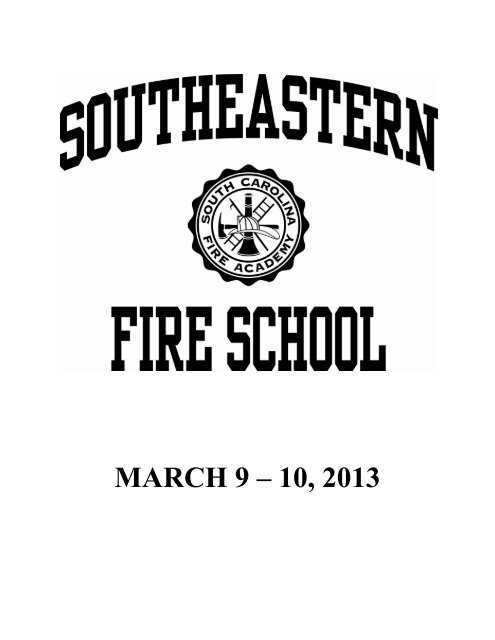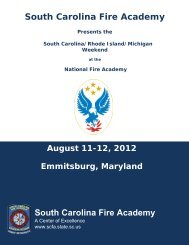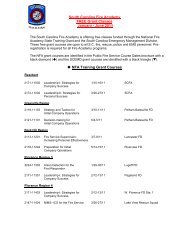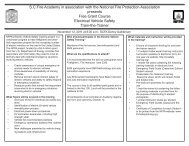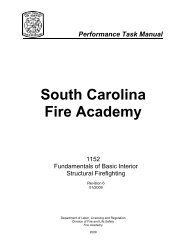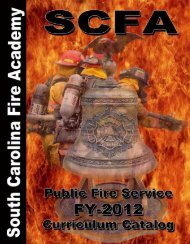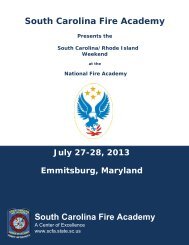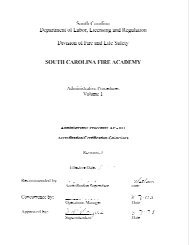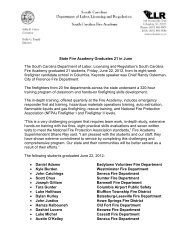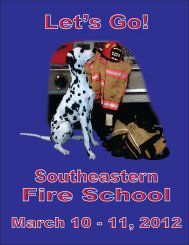MARCH 9 â 10, 2013 - South Carolina Fire Academy
MARCH 9 â 10, 2013 - South Carolina Fire Academy
MARCH 9 â 10, 2013 - South Carolina Fire Academy
Create successful ePaper yourself
Turn your PDF publications into a flip-book with our unique Google optimized e-Paper software.
Fulmer earned his Bachelor’s degree in <strong>Fire</strong> Science from Columbia <strong>South</strong>ern University in 20<strong>10</strong>.For four years, he has been an adjunct instructor at the SCFA teaching multiple disciplines witha concentration in ARFF training.Gary Peaton – Entering the fire service in 1992, Peaton enlisted in the U.S. Air Force as a fireprotection apprentice. Upon completing his fire academy at Chanute, AFB (Illinois), he wasstationed at Goodfellow AFB in Texas. In 2012, Peaton retired from Shawn AFB as MSgt (E-7),Assistant Chief and currently works as an adjunct instructor at the SCFA (since 2008) . He holdsmany certifications in numerous fields of the fire service including, fire, HAZMAT andspecialized rescue/confined space.Michael Seigler – Becoming a junior firefighter in 1983, Seigler worked his way through hisdepartment reaching the rank of assistant chief <strong>10</strong> years later. In 1990, Seigler was hired at theGreenville/Spartanburg International Airport as a firefighter. He received his basic ARFF trainingin Virginia (1991), and his advanced ARFF training from LSU (1995). He was promoted to Sr.<strong>Fire</strong>man in 1991, and became an instructor with the SCFA in 1992. Seven years later, he becamea lieutenant/training officer. Seigler obtained his Associates degree in Business Management in2001 and is currently working on his Bachelor’s degree in <strong>Fire</strong> Science. In 2006, Seigler joinedTyger River <strong>Fire</strong> Department as a volunteer and currently serves as a lieutenant. He has writtentwo articles that were published in international magazines (ARFF Working Group, Aviation <strong>Fire</strong>Journal). In 2007, he was a guest speaker at the 4 th Annual Aviation <strong>Fire</strong> Journal Conference inLas Vegas.Prerequisite:Students:Required PPE:1121 or 1152 or <strong>Fire</strong>fighter I or equivalent12 minimum / 25 maximumFull structural gear / SCFA will provide Scott SCBAsDefensive <strong>Fire</strong> Operation 5306-13001In many cases, an unsafe structure is entered to perform an interior attack when there is noneed. This program will teach students how to effectively perform a size up, keying in on cluesto help make an attack decision. This course focuses on the correct way to perform a defensiveattack. Objectives include apparatus placement and evaluation, correct master streamplacement to include elevated streams from an aerial apparatus, and fast attack lines tominimize manpower. This class is for those wanting to broaden defensive attack knowledge andto help keep firefighters safe.Instructor:Bill Guise – As a fire service instructor for more than 31 years, Guise is an IFSTA <strong>Fire</strong> Officer IVand Instructor III. He has provided fire training programs at the local, state and college level. Hereceived a Bachelor of Science fire science degree from the University of Maryland and is aretired captain from a federal government fire department. He also worked as a training officerwith Bluffton Township <strong>Fire</strong> District.Prerequisite: 1121 or 1152Students:12 minimum / 30 maximumRequired PPE: Full structural gear / SCFA will provide Scott SCBAs7 | P age
Air Monitoring - Breathe Safely 5324-13001The focus is on the concept of risk-based response in relation to four primary hazards:flammability, corrosive, toxicity, and radioactive atmospheres. Attendees are instructed ininterpreting meter displays, predicting chemical vapor behavior, sensor limitations, using printand electronic references to select action levels for various chemicals, and the steps to identifyunknown contaminants. Each type of sensor is evaluated for strengths/limitations and the classis presented with a simple method of classifying the atmosphere present. The hazards andphysical and chemical properties of carbon monoxide and hydrogen cyanide are discussed, asare the dangers they present to firefighters and civilians in the vicinity of a structure fire. Thetwo case studies that brought the dangers of HCN to the forefront are reviewed. Hands-onactivities will reinforce the interpretation of the values from the monitor.Instructors:Steve Curry – Serves as Columbia <strong>Fire</strong> Department’s chief of training and on the HazardousMaterials Company (17 years). He has been an SCFA instructor for 19 years, primarily focusingon HAZMAT programs. He is also an instructor with FEMA's Center for Domestic Preparedness(Alabama) where he teaches hazardous materials and WMD classes. He is the assistantHAZMAT team leader for the Midlands EMD Regional Response Team and functions as safetyofficer for the Midlands Type 3 IMT team. Curry is a contributing editor for two hazardousmaterial books.Todd Duncan – Serves as an Engineer with the Lancaster <strong>Fire</strong> Department, an adjunct instructorfor the <strong>South</strong> <strong>Carolina</strong> <strong>Fire</strong> <strong>Academy</strong> and works in the hazmat program office with the <strong>Academy</strong>.Todd has served the Lancaster <strong>Fire</strong> Department for 11 years. He is a member of the <strong>South</strong><strong>Carolina</strong> Hazmat Working Group and SCTF-1 as a Hazmat Specialist. In 1992 He received aBachelor’s Degree in Chemistry from Gardner Webb University.Prerequisite:Students:Required PPE:None15 minimum / 30 maximumNone9 | P age
Vendors will be allowed in the building:• Saturday (7 a.m. to 7 p.m.)• Sunday (7 a.m. to 1 p.m.)Vendor booths are open to the public:• Saturday (1:30 to 7 p.m.)• Sunday (8 a.m. to 1 p.m.)VENDOR INFORMATIONVENDOR PARTICIPATIONAnderson <strong>Fire</strong> & SafetyAssociation Behavioral Health CommitteeBurned Children’s Fund<strong>Carolina</strong> Gear MedixColumbia <strong>South</strong>ern University<strong>Fire</strong> Engine Collectibles<strong>Fire</strong> Programs SoftwareFisher SportswearFrog 911HEPACO, Inc.Safe IndustriesS.C. <strong>Fire</strong> <strong>Academy</strong>S.C. State <strong>Fire</strong>fighters Association<strong>South</strong>eastern <strong>Fire</strong>fighters Burn FoundationSpartan <strong>Fire</strong> & Emergency Apparatus14 | P age
DIRECTIONSFrom Interstate 20, take Exit 68 and turn north on Monticello Road (S.C. 215).Travel about 4.3 miles north to Monticello Trail and turn left. (The road will narrow from four totwo lanes about ¼ mile before the turnoff.)The <strong>Fire</strong> <strong>Academy</strong> complex is about ¼ mile down Monticello Trail on the left.15 | P age


